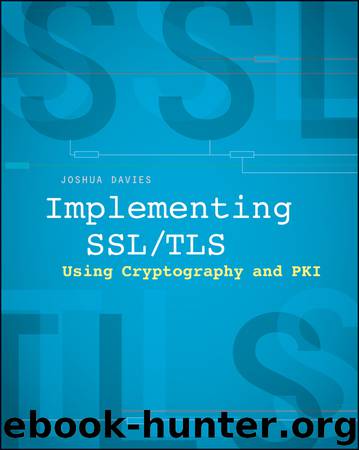Implementing SSL TLS Using Cryptography and PKI by Joshua Davies

Author:Joshua Davies
Language: eng
Format: epub
Publisher: Wiley
Published: 2011-01-04T16:00:00+00:00
So what are these P_MD5 and P_SHA1 blocks that are XORed together to produce the final result? Well, if you recall from Chapter 4, MD5 produces 16 bytes of output, regardless of input length, and SHA-1 produces 20. If you want to produce an arbitrary amount of data based on the secret, the label, and the seed using these hashing algorithms, you have to call them more than once. Of course, you have to call them with different data each time, otherwise you get the same 16 bytes back each time. P_[MD5|SHA1] actually use the HMAC algorithm, again, to produce the input to the final HMAC algorithm. So what goes into the HMAC algorithms that go into the HMAC algorithms? More HMAC output, of course! The seed is HMAC'ed once to produce the HMAC input for the first n bytes (where n is 16 or 20 depending on the algorithm), and then that is HMAC'ed again to produce the input for the next n bytes.
All of this sounds almost self-referential, but it actually does work. Figure 6.8 shows the P_MD5 algorithm, illustrated out to three iterations (to produce 48 = 16 * 3 bytes of output).
Figure 6.8 P_MD5
Download
This site does not store any files on its server. We only index and link to content provided by other sites. Please contact the content providers to delete copyright contents if any and email us, we'll remove relevant links or contents immediately.
| Cryptography | Encryption |
| Hacking | Network Security |
| Privacy & Online Safety | Security Certifications |
| Viruses |
Effective Threat Investigation for SOC Analysts by Yahia Mostafa;(7457)
Practical Memory Forensics by Svetlana Ostrovskaya & Oleg Skulkin(7178)
Machine Learning Security Principles by John Paul Mueller(7137)
Attacking and Exploiting Modern Web Applications by Simone Onofri & Donato Onofri(6809)
Operationalizing Threat Intelligence by Kyle Wilhoit & Joseph Opacki(6776)
Solidity Programming Essentials by Ritesh Modi(4565)
Microsoft 365 Security, Compliance, and Identity Administration by Peter Rising(4159)
Operationalizing Threat Intelligence by Joseph Opacki Kyle Wilhoit(3904)
Learn Computer Forensics - Second Edition by William Oettinger(3650)
Building a Next-Gen SOC with IBM QRadar: Accelerate your security operations and detect cyber threats effectively by Ashish M Kothekar(3638)
Future Crimes by Marc Goodman(3562)
Blockchain Basics by Daniel Drescher(3540)
Mastering Azure Security by Mustafa Toroman and Tom Janetscheck(3510)
Mastering Python for Networking and Security by José Manuel Ortega(3471)
Incident Response with Threat Intelligence by Roberto Martínez(3381)
The Code Book by Simon Singh(3136)
Mastering Bitcoin: Programming the Open Blockchain by Andreas M. Antonopoulos(3010)
Mobile App Reverse Engineering by Abhinav Mishra(2978)
From CIA to APT: An Introduction to Cyber Security by Edward G. Amoroso & Matthew E. Amoroso(2889)
